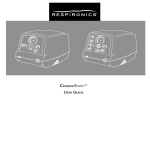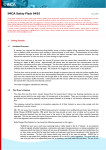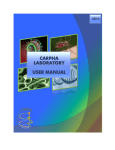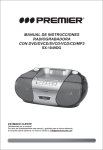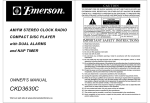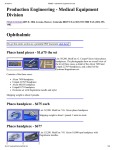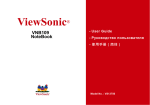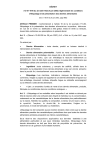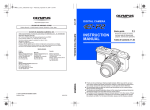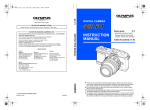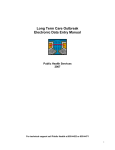Download Kirby Air Conditioner 5 User's Manual
Transcript
Kirby Morgan Air Control System 5 Operations and Maintenance Manual Part # 100-075 D IV c n . K Y MORGA B N IR I ES , YSTEMS KMDSI 1430 Jason Way Santa Maria, California United States of America Postal Code 93455 Telephone (805) 928-7772 Fax (805) 928-0342 Kirby Morgan Air Control System 5, KMACS 5, Dive Control System-2A, DCS-2A, DCS-3 and DCS-1 are trademarks of KMDSI . Use of these terms to describe products that are not manufactured by KMDSI is not permitted Manual prepared by Marine Marketing and Consulting & KMDSI . © 2003 KMDSI Document # 041112001 This page not used Definitions of Signal Words Used in this Manual DANGER: This word indicates an imminently hazardous situation, which if not avoided, will result in death or serious injury. WARNING: This word indicates a potentially hazardous situation, which if not avoided, could result in death or serious injury. CAUTION: This word indicates a potentially hazardous situation, which if not avoided, may result in minor or moderate injury. It may also be used to alert against unsafe practices. Warranty Information KMDSI warrants every new mask, helmet, SCUBA regulator or air control system (KMACS) (each, a Product) to be free from defects in workmanship for a period of ninety (90) days from the date of purchase from a KMDSI authorized dealer. This warranty covers all metal, fiberglass, and plastic parts, but does NOT cover rubber parts, communications components, or head cushions. Any defect of the product in workmanship or material covered by this warranty discovered within ninety (90) days from the date of purchase must be promptly communicated in writing to the nearest authorized KMDSI dealer or (if no such dealer in the buyer’s country) contact KMDSI directly at (805) 928-7772. No Product returns will be accepted by KMDSI without a returned merchandise authorization (RMA) number from KMDSI. Upon receipt of the RMA from KMDSI, the buyer should return the defective Product or part, freight prepaid, to an authorized KMDSI dealer or the KMDSI plant, as directed by the RMA. KMDSI will repair or replace the Product at no charge, within a reasonable time, as it deems necessary. This warranty is null and void if: 1) The Product is not registered with KMDSI within ten (10) days of purchase, or 2) The Product has not been properly serviced and/or maintained according to KMDSI factory recommended procedures described in the manual or Product updates have not been performed as recommended by KMDSI, or 3) Unauthorized attachments or modifications have been made to the Product, or 4) The Product has been used for purposes other than those for which it was designed, or otherwise has been abused, misused, or subjected to unusual conditions, or the Productís intended service has been exceeded. EXCEPT AS SPECIFICALLY PROVIDED HEREIN, THERE ARE NO OTHER WARRANTIES, EXPRESS OR IMPLIED, INCLUDING, BUT NOT LIMITED TO, ANY IMPLIED WARRANTIES FOR MERCHANTABILITY OR FITNESS FOR A PARTICULAR PURPOSE. THE PRODUCT COVERED BY THIS WARRANTY IS MARKETED AND SOLD BY KMDSI SOLELY FOR COMMERCIAL OR INDUSTRIAL USE AND IS NOT A CONSUMER PRODUCT INTENDED FOR PERSONAL, FAMILY, OR HOUSEHOLD USE. In purchasing any Product subject to this warranty, the buyer agrees that its sole and exclusive remedy and KMDSI’s entire obligation in contract, tort, or otherwise under this contract will be repair or replacement at KMDSI’s option of the Product or any parts which KMDSI determines during the applicable warranty period are defective in workmanship or material covered by this warranty. All exchanged parts are the property of KMDSI. The buyer’s exclusive remedy and the KMDSI’s entire liability in contract, tort, or otherwise is the payment by KMDSI of the buyer’s actual damages up to but not to exceed the amount paid by the buyer for the Product. In no event shall KMDSI be liable to the buyer for indirect, special, incidental or consequential damages (including, but not limited to, damages for lost profits, lost sales, loss of business opportunity, or for injury to persons or property arising out of the use of the Products). Any claim or action for breach of warranty must be commenced within one year following delivery of the Product to the buyer. Buyer acknowledges that this warranty is the sole and exclusive warranty of the Product and that it supersedes any and all oral or written representations and undertakings between KMDSI, its dealers, and the buyer relating to the Products. This warranty allocates the risks of product failure between KMDSI and the buyer, which allocation is recognized by both parties and is reflected in the price of the goods. The buyer acknowledges that it has read this agreement, understands it, and is bound by its terms. Table of Contents Section Title Page # Section Title Page # 1.0 General Information 1 2.3 Connecting the Air Supply 8 1.1 Definitions 1 2.4 Connecting Diver’s Hoses 9 1.2 Design Purpose 2 2.5 Pre-Dive Checklist 10 1.3 Specifications 3 2.5.1 Testing the L.P. Supply 10 1.4 General Description 3 2.5.2 Testing Communications 11 1.4.1 Breathing Air Sub System 4 2.5.3 Testing the Pneumo 12 1.4.2 Principle Operating Features 4 2.6 Preparing the Diver 12 1. Dive Control Panel 4 2.7 Dive Supervisor and KMACS Operator 12 2. Red Diver Depth Gauge 4 2.8 Descent 13 3. Umbilical Pressure Gauge 4 2.9 Diver at Depth 14 4. White Diver Depth Gauge 4 2.10 Changing out High Pressure Cylinders 14 5. Blue Air Supply Flow Indicator Line 4 2.11 Procedures During the Diver’s Ascent 14 6. Orange Air Supply Flow Indicator Line 5 2.12 Decompression 15 7. Low Pressure Inlet Fitting 5 2.13 Completion of Diving Operations 15 8. Blue Breathing Air Supply Gauge 6 3.0 Maintenance 16 9. Orange Breathing Air Supply Gauge 6 3.1 Recommended Maintenance 16 10. High Pressure Cylinder Yokes 6 3.2 Replacing the Battery 16 11. Bottom of Case 6 4.0 Troubleshooting 12. Air Supply Selector Valve Handle 6 13. Regulator Adjustment Knob 6 4.1 General 17 14. Outlet Manifold 7 4.2 No Communications 17 15. Pneumo Valve Handle, White Diver 7 4.3 No Pneumo Reading 18 16. Pneumo Valve Handle, Red Diver 7 4.4 No Air to the Diver 18 17 17. O-Ring Seal 7 5.0 Appendix 19 18. Communicator Panel 7 5.1 Emergency Procedures 19 19. Communicator 7 5.2 Diver Line Pull Signals 19 2.0 Operating Instructions 8 5.3 Communications Wiring Schematics 20 2.1 Unpacking the KMACS 5 8 5.4 Exploded Views & Parts Listz 20 2.2 First Use of KMACS 5 8 5.5 Dive Log Master Sheet 24 Kirby Morgan Air Control System 5 with no communications. Kirby Morgan Air Control System 5 with communications. KMACS 5 MANUAL Section 1.0 GENERAL INFORMATION 1.1 DEFINITIONS The following terms may be unfamiliar to the reader. They are defined as they relate to this manual and diving. All parts locations are referenced by LETTER on the diagram, Figure 5, Page 8. KMACS 5 : Kirby Morgan Air Control System 5. The Trademark name of the device this manual describes. The KMACS 5 contains all of the components necessary to properly control and monitor surface supplied air dives. Included in the KMACS 5 is a two-way voice communicator for talking between the KMACS 5 operator and the diver(s), or diver-todiver. The communicator operates in both the two wire and four wire mode. The KMACS 5 will supply plenty of air for two surface supplied divers. Scuba: Self contained underwater breathing apparatus. SSAir Diving: Surface Supplied Air Diving. Diving operation where the diver is supplied breathing air by way of a hose which is part of the diver’s umbilical from the surface. Usually the source of the breathing air is a compressor, but compressed air tanks on the surface can also be used. Diver’s Umbilical: Several components run together from the KMACS 5, (Dive Control System 2A) to the diver. These components are joined together, usually by tape, forming the umbilical. The most common components used in the diver’s umbilical are: (A) a hose through which the breathing air flows to the diver; (B) a multiconductor wire for communications transmission; (C) another (smaller) hose which is used to show the diver’s depth on the pneumofathometer (see below); (4) a strong line used as a strength member to prevent strain on the other components of the umbilical. The umbilical should be taped every 10 feet with colored tape to indicate the length of the hose. © 2003 KMDSI Document # 041112001 High Pressure (H.P.) Hose: A flexible hose designed to carry a working pressure of gas (or air) of more than 300 pounds (20.7 bars) per square inch. The rated working pressure is usually indicated on the hose and must not be exceeded. The working pressure of the high pressure hose on the KMACS 5 is 5000 psi (345 bars). Whip: A hose complete with fittings at each end for use in hooking up two pieces of deck equipment for gas (or air) flow. For instances, the hoses and fittings used to connect the KMACS 5 to the high pressure tanks are called “high pressure whips.” H.P.: High pressure. Usually any pressure over 300 psi. (20.7 bars). L.P.: Low pressure. Usually any pressure under 300 psi. (20.7 bars). Pneumofathometer: (pronounced “new-mo-fathometer”) This device measures the diver’s depth. A small hose, which is part of the diver’s umbilical runs from the KMACS 5 to the diver. The hose is open at the diver’s end and attaches with a fitting to a gauge at the KMACS 5. The gauge is calibrated in feet and meters of sea water. A valve is attached between the hose and the gauge so the operator can use a small amount of breathing air to purge water from the small hose. When the valve is shut off, excess air bubbles out of the hose at the diver’s end, and the air left in the hose will be at a pressure equal to the pressure of the water column. This is the exact depth of the diver. Pneumo: Short for pneumofathometer. Used such as “pneumo-gauge,” “pneumo -valve”, “pneumohose”, to describe the parts that make up the pneumofathometer subsystem. Dressed-in: A commercial diver’s suit was originally called a “dress.” Although the name changed KMACS 5 MANUAL to “suit” the term “dressed-in” has remained to describe putting the suit on. A diver who is “dressedin” has a suit on. The term is also used to describe a diver who, in addition to his suit, has more, or all of his/her equipment on. Bailout Bottle: This is the emergency tank of breathing gas. “Bailout” which is the familiar term for parachuting from an airplane, also applies to the shallow water diver who ditches part of his diving gear and swims to the surface. The “bailout” bottle term came from this use. The bailout bottle is an independent air source connected directly to the diver’s mask or helmet via a first stage scuba regulator and hose. The first stage regulator must be equipped with an overpressure relief valve (Part #200-015). The overpressure relief valve will vent pressure in the event of a first stage leak and prevent the low pressure hose from rupturing, causing a complete loss of the diver’s bailout supply. The bailout bottle is worn on the diver’s back, mounted to a harness. The diver’s umbilical should be attached to this harness to prevent a direct pull on the diver’s mask or helmet. The size/volume of the bailout bottle should be determined by the diver’s depth, or the distance required for a direct ascent to the surface. For deeper dives, or penetration dives inside wrecks or pipelines, a larger capacity bailout bottle should be used. 1.2 DESIGN PURPOSE The Kirby Morgan Dive Control System 5 (KMACS 5) is designed to provide a central control center for the operator/dive supervisor during a surfacesupplied air dive. Provisions for the control of the breathing air supply, diver depth monitoring, and voice communications are all located on a simple panel. The KMACS 5 is a full service control system for all Surface Supplied Air diving operations. The KMACS 5 is fitted with shut off valves on the diver’s air supply. The shut off valves are designed to allow air to be shut off on either or both of the diver’s umbilicals. When the handles of the valves are vertical the valves are open and air is flowing to the divers. When the valve handles are horizontal the valves are shut and the air to the divers umbilicals is off. By having total control located at one panel, the KMACS 5 operator can rapidly respond to the diver’s needs without leaving the control station. In a standard commercial SSAir diving operation the KMACS 5 provides a backup air supply system which the operator can activate in the event of the main air supply failure (such as compressor malfunction). This can be accomplished without leaving the control panel, which allows the operator to inform the diver and continuously monitor umbilical supply pressure and depth at the same time. The compact size of the KMACS 5 usually makes it possible to locate it at the water entry site, allowing the operator to tend the diver’s umbilical while maintaining control of the KMACS 5. In addition to its compact size, the ability of the KMACS 5 to use high pressure air allows SSAir diving from small boats or remote locations where transportation and setup of a compressor would be impractical. Two or more standard scuba bottles can be used as the breathing air supply. Fig. 1 Divers with all of the gear they need to dive. For example, when commercial divers are working on an offshore rig, a common SSAir diving job is the inspection and cleaning of a propeller on a crew boat. This job can be performed easily and simply with the KMACS 5, a couple of scuba bottles, a full face mask or helmet, and an umbilical. Transporta© 2003 KMDSI Document # 041112001 KMACS 5 MANUAL tion to the job site is simple and a large surface support vessel is not needed. At the dive site, full communications, backup breathing supply, pressure readouts, and depth monitoring are provided by the KMACS 5. This is one of many situations where the KMACS 5 can be used to provide the safe and efficient operation of SSAir diving. 1.3 SPECIFICATIONS Use: For SSAir diving only. Pure oxygen MUST NOT be used. Compressed air from high pressure tanks (scuba or other types of compressed air tanks), or from a compressor should be the only supply to the KMACS 5 CAUTION: Pure oxygen is a potential fire hazard, its use can lead to explosion of the KMACS 5. Pure oxygen also presents a physiological hazard to the diver. Outer Dimensions: Length = 21 inches Width = 10 1/2 inches Height= 17 1/2 inches Weight: 54 pounds. (24.5 kilos) Shipping Weight: 60 pounds. (27 kilos) Recommended Maximum Dive Support Depth: 130 fsw (feet of sea water) (40 meters). CAUTION: Decompression and other human limits must be observed. Decompression diving should not be conducted with the KMACS 5 unless a properly equipped recompression chamber facility with oxygen is immediately available at the dive site. In-water decompression is not recommended. High Pressure Supply Pressure Maximum: 4500 pounds per square inch. (300 bars) Low Pressure Supply Pressure Maximum: 225 pounds per square inch. (15.5 bars) © 2003 KMDSI Document # 041112001 CAUTION: Although the high pressure gauges on the KMACS 5 are rated to 5000 psi (345 bars), this is a safety precaution only. The regulator on the KMACS 5 is not designed to operate at pressures greater than 4500 psi (300 bars). Umbilical Pressure Range: 115-225 pounds per square inch. (8-15.5 bars) Regulator Output: 40 SCFM at 2500 psi (172 bars) supply pressure with 150 psi (10.3 bars) delivery pressure. Relief Valve: Set at 300 psi (20.7 bars). Pneumofathometer Range: 0-250 FSW (feet of sea water) (0-76 meters). Communicator: 4 wire system. Can also be used in 2 wire mode. Battery Type: Rechargeable, 12 volt system. Battery Performance: 20 hours of continuous use between charges in 4 wire mode. Charger: Will accept external 12 volt source. Communicator Power Output: 8 watts. Communicator Frequency Response: 600 to 12,000 HZ. Remote Operation Capability: Yes, with optional unit. Direct Recording Capability: Yes. 1.4 GENERAL DESCRIPTION Only equipment certified and tested according to EN 250/E DIN 58 642 may be used with the KMACS 5 when conducting diving operations in European EC compliant countries. The KMACS 5 components are housed in a durable polyethylene case. However, caution should be used in transporting the KMACS 5. Rough handling will rarely cause damage to the case, but it is possible to damage the calibrated pneumo gauges and/or KMACS 5 MANUAL the electronic components. The KMACS 5 should be treated as you would any expensive life support equipment. 1.4.1 BREATHING AIR SUBSYSTEM The diver’s breathing air subsystem starts with the supply tank yokes (K) and connects to the diver’s supply manifold. The high pressure hoses with the yokes are stored for transit by connecting them to the posts on the panel inside the lid of the KMACS 5. The knurled knobs on the yokes should be tightened until just snug. Excessive force should not be applied. 1.4.2 PRINCIPLE OPERATING FEATURES l. DIVE CONTROL PANEL (A) The panel is the main frame to which the functional components are mounted. In addition, the component names and some instructions are on the panel. The blue and orange lines (K, Q) on the panel represent the flow paths of supply air from the two high pressure hoses/yokes (S). 2. RED DIVER DEPTH GAUGE (C) (PNEUMOFATHOMETER) This gauge indicates the “red” diver depth. The red diver pneumo valve knob (D), is turned to supply a small volume of air to the small pneumo hose that is part of the diver’s umbilical. The gauge reads the pressure of the air in the pneumo hose. This pressure, measured in feet (or meters) of sea water, equals the water pressure at the diver’s depth. 3. UMBILICAL PRESSURE GAUGE (B) This gauge (B) is connected to the low pressure air supply system that supplies both umbilical fittings. It indicates the breathing air pressure that is in both the “red” and “white” diver umbilicals. When the air supply is from high pressure tanks (such as scuba tanks) the umbilical hose pressure can be varied by turning the regulator adjustment knob (H) 4. WHITE DIVER DEPTH GAUGE (P) (PNEUMOFATHOMETER) This gauge indicates the “white” diver depth. The white diver pneumo valve knob (O), is turned to supply a small volume of air to the small pneumohose that is part of the diver’s umbilical. The gauge reads the pressure of the air in the pneumo-hose. This pressure, measured in feet (or meters) of sea water, equals the water pressure at the diver’s depth. 5. BLUE AIR SUPPLY FLOW INDICATOR LINE The “BLUE” air supply flow indicator line (Q) indicates the flow path of breathing air from entry into the KMACS 5 to exit to the diver’s umbilical(s) at the fittings on the manifold (G). There are two high pressure whips which are color coded BLUE and ORANGE. Starting from the high pressure air tank, the BLUE air supply flows through the whip into the KMACS 5. Following the BLUE flow indicator line (Q) it shows the flow to the BLUE Breathing Air Supply Pressure Gauge (M), then to the Breathing Air Supply Selector Valve which is controlled by the Breathing Air Selector Valve Handle (I). The Selector Handle (I) must be turned all the way “UP” until it stops for the BLUE supply. This places the selector valve handle in line with the flow path indicating the “BLUE” air supply (Q). The ORANGE supply is off when the Selector Handle is in the up position. CAUTION: When using H.P. air, the selector handle must be turned up until it stops for BLUE supply or down until it stops for Orange supply. Never allow the selector handle to stay in the marked “H.P. OFF ZONE”. Both high pressure air supplies are off in the yellow striped H.P. OFF ZONE”. After flowing through the Selector Valve the BLUE air supply enters the Breathing Air Supply Regulator (H) which reduces the high pressure breathing air to an adjustable range between 115-225 pounds per square inch (psi) (8-15.5 bars). The BLUE air supply then goes to both diver’s umbilicals through the fittings on the manifold (G). © 2003 KMDSI Document # 041112001 KMACS 5 MANUAL 6. ORANGE AIR SUPPLY FLOW INDICATOR LINES After flowing through the Selector Valve the ORANGE air supply enters the Breathing Air Supply Regulator (H) which reduces the high pressure breathing air to an adjustable range between l15-225 psi (8-15.5 bars). Then the ORANGE air supply goes to both diver’s umbilicals through the fittings on the manifold (G). The “ORANGE” air supply flow indicator line indicates the flow path of breathing air from entry into the KMACS 5 to exit to the diver’s umbilical(s) at the fittings on the manifold (G). The second high pressure whip is color coded ORANGE. Starting from the high pressure air tank, the ORANGE air supply flows through the whip into the KMACS 5. Following the ORANGE flow indicator line (K) it shows the flow to the ORANGE Breathing Air Supply Pressure Gauge (L), then to the Breathing Air Supply Selector Valve which is controlled by the Breathing Air Selector Valve Handle (H). The Selector Handle must be all the way “DOWN” until it stops for the ORANGE supply. The BLUE supply is off when the Selector Handle is in the down position. 7. LOW PRESSURE INLET FITTING (N) The low pressure inlet fitting is positioned between the connections for the two H.P. supply hoses. It is marked by the arrow containing the words “L.P. Supply”. Low pressure supply breathing air, usually from a compressor (with volume tank) is supplied through a whip (low pressure hose and fittings) that attaches here. When the low pressure supply is the only air source, the supply pressure will be indicated on the umbilical pressure gauge (B). In the low pressure supply mode, the selector/valve handle will he positioned in the H.P. OFF ZONE. CAUTION: When using H.P. air, the selector handle must be turned up until it stops for BLUE supply or down until it stops for ORANGE supply. Never allow the selector handle to stay in the marked “H.P. OFF ZONE”. Both high pressure air supplies are off in the yellow striped H.P. OFF ZONE”. A B C D E F G H I J K L M N O P Q R S T U V Dive Control panel Umbilical Pressure Red Diver Depth Gauge Pneumo Valve Handle, Red Divers Umbilical Breathing Hose Attachment Fittings Pneumofathometer Hose Attachment Fittings Outlet Manifold Regulator Adjustment Knob B Breathing Air Supply Selector Valve Handle C Case Orange Air Supply Flow Line D Orange Breathing Air Supply Gauge Blue Breathing Air Supply Gauge E Low Pressure Inlet Fitting Pneumo Valve Handle, White F White Diver Depth Gauge Blue Air Supply Flow Line Communicator Yokes w/DIN Fittings for H.P. Cylinder Attachment G Access door for storage compartment. O-Ring Seal Communicator Panel Fig. 2 © 2003 KMDSI Document # 041112001 T S U V R A Q P O N H I J K L M KMACS 5 MANUAL Blue Air Supply Flow Path Indicator Line Blue Air Supply Whip half of the case (J). The top half of the case contains the communicator panel with the yoke blocks and the communicator if there are communications. If there are no communications there are only the yoke blocks. ( see picture in front of manual). The top is not designed to be removed. 12. BREATHING AIR SUPPLY SELECTOR VALVE HANDLE (I) Orange Air Supply Whip Orange Air Supply Flow Path Indicator Line Fig. 3 Air flow paths from the H.P. cylinders. 8. BLUE BREATHING AIR SUPPLY PRESSURE GAUGE (M) The Blue pressure gauge (M) indicates the pressure remaining in the “BLUE” high pressure tank. (NOTE: If two divers are supplied by the KMACS 5 both divers will be breathing from the same selected high pressure supply). 9. ORANGE BREATHING AIR SUPPLY PRESSURE GAUGE (L) The Orange pressure gauge (L) indicates the pressure remaining in the “ORANGE” high pressure tank. (NOTE: If two divers are supplied by the KMACS 5, both divers will be breathing from the same selected high pressure supply). 10. YOKES FOR HIGH PRESSURE CYLINDER ATTACHMENT (S) This handle (I) controls the two position Breathing Air Supply Selector Valve and allows uninterrupted diving operations while full air supply tanks replace expended tanks. The selector valve controls ONLY the high pressure air supply. It is NOT possible to shut off any low pressure supply connected to the low pressure inlet fitting (N), at the KMACS 5 itself. CAUTION: When using H.P. air, the selector handle must be turned up until it stops for BLUE supply or down until it stops for ORANGE supply. Never allow the selector handle to stay in the marked “H.P. OFF ZONE”. Both high pressure air supplies are off in the yellow striped H.P. OFF ZONE”. When changing out the H.P. air supply cylinders, always observe the diver’s umbilical pressure gauge (B) for any sudden fall in pressure. Should this occur, it indicates that the cylinder in use has mistakenly been turned off. If so, immediately turn the cylinder back on and move the selector valve handle to select the full cylinder and change out bottles. Due to the construction of the selector valve, it is impossible for gas to back-flow from one cylinder to the other. The yoke fittings (S) provided have standard U.S. scuba cylinder attachments as well as Din Fittings. Each yoke has a bleeder valve to vent the remainder of the pressure in the whip when changing out scuba bottles. The yokes attach to posts mounted on the panel in the lid of the KMACS 5 for storage and transport. 11. CASE (J) The Dive Control panel (A) is attached to the bottom © 2003 KMDSI Document # 041112001 KMACS 5 MANUAL 13. REGULATOR ADJUSTMENT KNOB FOR UMBILICAL PRESSURE (H) The regulator Adjustment Knob (H) allows the operator to adjust the umbilical pressure within a range of 115 psi to 225 psi (8-15.5 bars). Incoming high pressure air from the ‘ORANGE” or “BLUE” supply is reduced by the internal regulator. The Adjustment Knob controls the regulator. Turning the Knob clockwise decreases the umbilical pressure; counterclockwise increases it. 14. OUTLET MANIFOLD INCLUDING DIVER’S UMBILICAL FITTINGS (G) The “WHITE DIVER” and “RED DIVER” air supply hoses are connected to the KMACS 5 at the manifold (G). The fittings coming out of the KMACS 5 are male #6 JIC (3/8”, 37°) flared fittings. The diver’s air supply hoses must have matching female #6 JIC flared fittings with swivel nuts. The “WHITE DIVER” and “RED DIVER” pneumofathometer hoses are also connected to the KMACS 5 at the manifold (G). The fittings coming out of the KMACS 5 are male #4 JIC ( 1/4”, 37°) flared fittings. The diver’s pneumofathometer hoses must have matching female #4 JIC (1/4”, 37°) flared fittings with swivel nuts. 15. PNEUMO VALVE KNOB, WHITE DIVER (O) The Pneumo Valve Knob, White Diver turns on and off the air supply to the “WHITE” pneumofathometer system. 17. O-RING SEAL (U) The O-ring seal helps keep dust and moisture out of the KMACS 5 when the case is closed. The O-ring seal is not pressure proof, however, and the KMACS 5 case will flood if the box is submerged. 18. COMMUNICATOR PANEL (V) The diver’s electronic communicator (R) is attached to the communicator panel. The battery for the communicator is located behind this panel. 19. COMMUNICATOR (R) The MK3-KMDSI communicator is a standard open circuit/round robin diver’s communicator, which functions like a telephone. It can also be used as a 2 wire, “push-to-talk” system. It is connected to the diver’s umbilicals by “banana plug” fittings on the communicator. The communicator is mounted on the communicator panel. You should read and understand the accompanying radio operations manual supplied with the unit before using the unit. Improper use or connections could damage the radio. CAUTION: Never connect the charger during a dive or when anyone is in contact with connected equipment. Although electrical shock danger is remote, connection of the recharging cord should only be done when the KMACS 5 is not in use. 16. PNEUMO VALVE KNOB, RED DIVER (D) The Pneumo Valve Knob, Red Diver turns on and off the air supply to the “RED” pneumofathometer system. © 2003 KMDSI Document # 041112001 KMACS 5 MANUAL Section 2.0 OPERATING INSTRUCTIONS 2.1 UNPACKING THE KMACS 5 2.2 FIRST USE OF THE KMACS 5 When you first receive your KMACS 5, carefully unpack it and examine it for any damage that may have occurred during shipment. Be sure to complete the enclosed warranty card and return it to KMDSI immediately. No warranty claims will be honored without a satisfactorily completed warranty card on file at KMDSI. Place the Dive Control System on a firm surface. The KMDSI logo should be right side up. Release the latches and lift up the lid to expose the panels. Visually check the KMACS 5 to ensure that it has not been damaged in transport. When using the KMACS 5 aboard a vessel subject to waves or swell be sure to tie the KMACS 5 securely in position so that it doesn’t fall. Thread a piece of line through the handles and fasten the ends to fittings on the boat. Tie back the lid of the KMACS 5 as well to prevent damage or injury. 2.3 CONNECTING THE AIR SUPPLY Loosen the knurled knobs which connect the yokes to their storage posts in the KMACS 5 and remove the yokes (S) from the blocks. Attach each yoke to a high pressure cylinder as you would connect a scuba regulator to a tank. The knobs on the yoke should be screwed down finger tight. Do not apply Fig. 5 Note the line which passes through the handle of the KMACS 5 and is secured to the rail to prevent the KMACS 5 from moving about. Fig. 6 Connecting a scuba air supply to the KMACS 5. © 2003 KMDSI Document # 041112001 KMACS 5 MANUAL excessive force to the knobs; air pressure from the tanks will create a good seal. Be sure the bleed valve on each yoke is in the closed position. Do not turn the cylinders on at this time. Prior to connecting the low pressure hose to the KMACS 5, the deck whip should be flushed with air to make sure no foreign matter is in the hose. Connect the deck whip to the low pressure compressor and while firmly holding the end of the hose start the compressor and flow air through the deck whip for at least one minute. Attach the low pressure hose to the low pressure inlet fitting (N) and screw the fitting down finger tight. While using one wrench to hold the low pressure inlet fitting tighten the hose fitting with a second wrench. Do not use excessive force as this will only damage the fitting and cause it to leak. 2.4 CONNECTING DIVER’S HOSES TO THE KMACS 5 Each diver’s umbilical should be color coded with plastic tape to identify each individual hose. This action will not only serve to make it easier to connect the hoses, but will also serve to differentiate between hoses for purposes of inspection or repair. Fig. 7 Always use the right size wrench to connect the hoses to the KMACS 5. Check the function of the selector handle to ensure correct operation. If available, a low pressure compressor should be used as the primary air supply and scuba cylinders should be used as a backup, or reserve air source. CAUTION: Low pressure compressors used for breathing air should be specifically designed for diving. Paint compressors or similar equipment are unacceptable for diving applications. (Contact KMDSI for a list of equipment manufacturers who supply compressors with breathing quality air). DANGER: If a low pressure compressor is used, the intake must be at a sufficient distance from and upwind of the exhaust. If exhaust gas is sucked into the intake, the diver will suffer from carbon monoxide poisoning. This can be fatal. © 2003 KMDSI Document # 041112001 A standby diver should always be equipped and ready to go to the diver’s aid whenever a surface supplied diver is working in the water. Generally, it is not necessary for more than one diver to be in the water at a given time when using surface supplied gear. However, a standby diver is considered essential for safe, surface supplied operations. The standby diver can be either a scuba diver or another hose supplied diver since the KMACS 5 provides enough air for two hose supplied divers. In contaminated water diving operations, however, both divers must be equally equipped with a vulcanized rubber dry suit, dry gloves, and Kirby Morgan dive helmet equipped with either a double exhaust system or the new TriValve™ exhaust system. CAUTION: Contaminated water diving operations are very hazardous. They should not be attempted without specialized training, procedures, and equipment. Remove the protective caps from the outlets of the manifold (G) on the console. Connect the diver’s umbilical hose fittings (air supply hose and pneumo) to the KMACS 5. Remove the end caps from the hoses themselves and while firmly holding the end of the hose, blow out the lines before connecting the KMACS 5 MANUAL hoses to the mask or helmet, (refer to the manual for the mask or helmet for the proper connection procedures for your life support equipment). This action will prevent any foreign matter from entering the helmet or mask breathing system. Once the hose is blown out, immediately connect the fitting on the hose to the fitting on the mask or helmet. Connect the communications portion of the diver’s umbilical to the communications fittings on the communicator and to the mask or helmet. Be sure the proper connection is made with the right communications line for each diver. The wires in the diver’s umbilical should be marked so it is easy to identify which plug connects to the earphone terminals and which plug connects to the microphone terminals. 2.5 PRE-DIVE CHECK Prior to EVERY dive, the following should be checked: With the free flow and demand regulator on the mask/helmet(s) shut off, turn on the air supply at each of the air cylinders. During operation with scuba bottles as the main supply, the selector valve handle must be FULLY up or FULLY down. Fully up turns the “BLUE” supply on and the “ORANGE” supply off. Fully down turns the “ORANGE” supply on and the “BLUE” supply off. Note the air pressure in each cylinder by reading the gauges (L,M). The low pressure supply should be switched “OFF” at the source at this time. A check valve in the low pressure system prevents back flow to the compressor. Both cylinders should be full prior to diving. Load the regulator on the KMACS 5 using the regulator adjustment knob (H). Observe the umbilical hose pressure (B) which should be set at 150 psi (10.3 bars) over top side pressure, or 165 psi (11.5 bars) The regulator used in the KMACS 5 is a non-venting regulator. If the regulator has been left set at a higher pressure setting than is presently desired, the operator must turn the regulator adjustment knob (H) clockwise and vent air from the system by bleeding either the pneumo system or diver’s breathing apparatus. umbilical pressure is always 150 psi (10.3 bars) over the pressure at the diver’s depth. Consult the table below for approximate pressure settings. TABLE 1 Suggested Regulator settings for the KMACS 5 Depth - fsw Pressure Optimal Minimum 0’ 14.7 psia 150 psig 150 psig 33’ 29.4 psia 165 psig 150 psig 66’ 44.1 psia 180 psig 150 psig 99’ 58.8 psia 195 psig 160 psig 132’ 73.5 psia 210 psig 175 psig 165’ 88.2 psia 225 psig 190 psig 198’ 102.9 psia 225 psig 205 psig TABLE 1, Metric Suggested Regulator settings for the KMACS 5 Depth-Meters Pressure Optimal Minimum 0 1 bar 10.3 bars 10.3 bars 10 2 bars 11.4 bars 10.3 bars 20 3 bars 12.4 bars 10.3 bars 30 4 bars 13.4 bars 11.0 bars 40 5 bars 14.5 bars 12.1 bars 50 6 bars 15.5 bars 13.1 bars 60 7 bars 15.5 bars 14.1 bars 2.5.1 TESTING L.P. SUPPLY With the air on at the bottles and the communications switched on, check the regulator function. The diver should insert his face in the mask/helmet and take several breaths to test the demand regulator. To test the low pressure supply, place the selector valve handle (I) in the “H.P. OFF” zone and the console will be running off the low pressure supply only. Observe the umbilical pressure gauge (B). As the compressor cycles, the gauge will rise and fall as the compressor’s volume tank fills and empties. The maximum pressure for the L.P. inlet should be 225 psi. Again, check the mask/helmet function which will also confirm the low pressure supply routing. As the diver descends, the KMACS 5 operator should increase the regulator setting so that the 10 © 2003 KMDSI Document # 041112001 KMACS 5 MANUAL 2.5.2 TESTING COMMUNICATIONS Test the communications between the diver and the KMACS 5. With the communicator (R) switched on, turn the speaker switch to “on” and adjust the volume to a comfortable level for both the diver and the KMACS 5 operator. In the 2 wire mode, the communicator functions similarly to a citizens band radio; i.e., the KMACS 5 operator must depress the push to talk switch to speak to the diver. In the 4 wire mode, the communicator functions like a telephone conference call; i.e., everyone on the line can hear and speak to everyone else. In either mode, for the diver to talk top side, it is only necessary for him to speak into the oral/nasal microphone in his mask or helmet. If two divers will be working together, test the cross-talk functions at this time as well. To extend the life of the battery, it is recommended that the communications be used in the 4 wire mode. Operation as a 2 wire system uses relays inside the unit which will cause a higher battery drain. CAUTION: In the 2 wire mode, when the push-to-talk switch is depressed, the KMACS 5 operator should keep all of his communications short (10-15 seconds) at any one time. This allows the diver to call for assistance if necessary. Plug the earphone connectors on the diver’s umbilical into the earphone jacks on the communicator. Plug the microphone connectors on the umbilical into the microphone jacks on the communicator. This will create a 4 wire system/round robin system. Test the system and adjust all volume controls. Unplug the earphone connectors on the diver’s umbilical from the communicator and reinstall them in the connectors attached to the plugs for the microphone. This will change the communicator to a 2 wire system. Test this system and adjust volumes. If there are no communications, recheck all of the connections to ensure they are tight at each junction. If the KMACS 5 has been operating in a coastal environment, look for corrosion on the top side connectors which may interfere with the communications. If corrosion is evident, disassemble the connectors, clean, and retest. If corrosion is heavy, replace the top side connectors. Substitute other masks or umbilicals to test for failures in the microphones or umbilical. Substitute one piece of new gear at a time to track the fault down. If the fault is in the mask or helmet, replace the earphones or microphones as needed. If the fault is in the umbilical, disconnect the umbilical and carefully inspect its length for damage. Look for obvious nicks or cuts. If there is physical damage to the outside of the communications wire there probably is a break on the inside, too. Test the continuity of the wire end-to end with a volt-ohmmeter. Uncoil the umbilical and lay it out flat with the two ends close to each other. Set the volt-ohmmeter to resistance (ohms) and hold one probe to one prong on an umbilical connector plug and touch the other probe from the meter to the wires (or connector) at the opposite end of the diver’s umbilical. Upon locating the other end of the same wire, the meter should indicate zero resistance, i.e., there is a complete, uninterrupted circuit. If touching none of the wires at the other end of the umbilical produces a zero reading and all readings are infinity (∼), this indicates a complete break in the wire. If the reading is somewhere between zero and infinity, and changes as the umbilical is moved, this indicates a partial break, and communications will be intermittent. In either case, a waterproof splice must be made in the wire. Fig. 8 Preliminary testing of the umbilical with a volt-ohm meter to check for continuity. © 2003 KMDSI Document # 041112001 11 KMACS 5 MANUAL 2.5.3 TESTING THE PNEUMO 2.6 PREPARING THE DIVER The pneumo supply may be tested in either the high pressure supply mode or the low pressure supply mode. To test the pneumo, select either mode and pinch the open end (diver’s end) of the red diver pneumo hose. With the hose crimped tightly shut, slowly open the red pneumo valve (D) momentarily, 1/4 turn, and observe the needle’s response on the red diver depth gauge (C). The diver should be dressed in with the appropriate exposure suit for the local water temperature. The diver should be equipped with a harness to provide an attachment point for his umbilical. By attaching the umbilical to the harness, the possibility of a direct pull on the diver’s helmet or mask will be eliminated. A bailout bottle should be mounted on the diver’s harness. Always dive with a bailout bottle, no matter how shallow the dive. The danger of entanglement is always present and a bailout bottle will give the diver that few extra minutes to free himself in the event he becomes hung up on fishing line, wire, or other submerged objects. The bailout regulator should be equipped with a quick disconnect whip to make it easier to dress the diver in and out. In addition, the bailout regulator should also be equipped with an over pressure relief valve (Part #200-015). This will permit the regulator to bleed off and not rupture the low pressure hose connecting it to the diver’s bailout or emergency valve, should the first stage develop a leak. With the hose attached to the harness, tuck the pneumo hose under the harness at the diver’s chest. This serves two purposes: 1) it provides instant access in the event the pneumo is to be used as an alternative air supply; 2) gas absorption and elimination of nitrogen is considered to occur at the diver’s chest level. Fig. 9 Carefully test the pneumo prior to every dive. CAUTION: Do not “peg” the needle on the pneumofathometer with a maximum reading. A test of pressure equal to 50 feet (15 meters) on the gauge is satisfactory to ensure correct operation. Close the valve after observing correct operation and release the end of the pneumo hose. The gauge needle should return to zero. Repeat the above procedure for the white diver. 12 When diving under a potential decompression situation, a depth gauge or dive computer should be worn by the diver as a backup system. If decompression is anticipated there must be enough air on hand for the diver to complete the dive and the decompression obligation. 2.7 THE DIVE SUPERVISOR AND THE KMACS 5 OPERATOR During the diving operation, one person should always be in charge to avoid confusion. Generally, this should be the most senior diver, by virtue of his diving experience. © 2003 KMDSI Document # 041112001 KMACS 5 MANUAL The dive supervisor may not always be the KMACS 5 operator. The dive supervisor may want or need the freedom to direct the entire operation including the tenders and other personnel. As such, he is responsible for making decisions regarding diving conditions and safety. However, the KMACS 5 operator must always be an experienced diver who understands the diver’s needs and has the diver’s best interests always in mind. CAUTION: The KMACS 5 operator must not leave the dive control system unattended while the diver is in the water. The KMACS 5 operator is directly responsible for the diver’s safety and well being. The diver must follow the KMACS 5 operator’s directions in regards to depth and time. The diver can NOT run the dive from the bottom. Thus, when the dive supervisor himself is required to dive he should relinquish control to the next most senior diver remaining top side. 2.8 DESCENT Upon entering the water, the diver should immediately recheck communications with top side and ensure that his mask or helmet is working correctly. When he/she is ready to descend he should notify the KMACS 5 operator that he is, “Leaving the surface.” Both the diver and tender should communicate in a normal tone of voice. It should not be necessary for either person to shout to be heard. Although the quality of the communications will usually be excellent, not all divers speak clearly. The KMACS 5 operator should listen carefully at all times to what the diver is saying. Once the diver has entered the water, monitor his descent rate using the pneumo valve (D,O) and gauge (C,P). The diver’s descent rate should not exceed 75 feet (23 meters) per minute. As the diver descends, the KMACS 5 operator should adjust the regulator (H) on the KMACS 5 to provide 150 psi (10.3 bars) over the pressure at the diver’s depth at all times. This provides the best breathing performance from the diver’s demand regulator. © 2003 KMDSI Document # 041112001 Fig. 10 KMACS 5 operator taking a reading with the pneumo knob. The knob should be turned very slowly. It is essential that the KMACS 5 operator keep pace with the diver’s descent and not lag behind in his depth monitoring. If this occurs, it is possible for the diver to exceed his maximum planned depth without the KMACS 5 operator being aware this has occurred. To operate the pneumo, turn the knob for the appropriate diver, counter clockwise, until the indicator needle on the depth gauge starts moving. When the depth gauge for the individual diver indicates a depth that is known to be deeper than the diver, the knob is turned clockwise until it is off. The indicator needle on the depth gauge will move shallower as the air bubbles leave the open end of the pneumo hose at the diver. When the needle stops, that is the diver’s actual depth. Most umbilicals are made up with the diver end of the pneumo hose having about two feet (.6 meters) of loose hose. The diver can use this hose as an air supply for inflating lift bags or for taking an exact 13 KMACS 5 MANUAL reading of the bottom depth. In an emergency, the pneumo air can be used as a breathing air supply for a diver. The diver tells the KMACS 5 operator to “Turn on the pneumo-air...”, then inserts the hose into the mask or helmet. When using the pneumo in this mode the air pressure should be regulated by the KMACS 5 operator to be slightly greater than the diver’s depth. For example, if the diver is at 100 feet (30 meters), the pneumo should be opened until the gauge reads a depth of 110 feet (33 meters), so that a positive pressure exists. The diver should practice using the pneumo as an alternative air source under controlled conditions in shallow water. The pneumo hose should be bubbling when it is inserted in the diver’s mask, otherwise the diver will receive a blast of water when the pneumo is first turned on. 2.9 DIVER AT DEPTH Once the diver reaches the bottom, or his maximum planned depth, the diver should inform the KMACS 5 operator that he is, “On the bottom.” At this time, the KMACS 5 operator should ensure that he gets an accurate depth reading. The KMACS 5 operator should inform the diver that he is “Taking a pneumo...”, when he opens the pneumo purge valve. The diver should observe the end of the pneumo hose and immediately inform top side that, “He has bubbles...”. Once the diver has a flow of bubbles at the end of the hose, the pneumo valve (D,O) should be closed immediately. Should the diver move deeper at any time during his dive he must inform the KMACS 5 operator and another pneumo should be taken for a new maximum depth reading. If the KMACS 5 operator knows that the diver is moving over an uneven bottom he should periodically take additional pneumo readings to ensure that the diver has not accidentally gone deeper and neglected to notify top side. Keep in mind, however, that every pneumo reading does use some air. If high pressure air is the air source and the dive is deep, or the diver is working hard, pneumo readings should be taken as sparingly as possible. 14 2.10 CHANGING OUT HIGH PRESSURE CYLINDERS The KMACS 5 operator should continuously monitor the diver’s air supply at the two high pressure gauges (L,M) when diving with high pressure air as the primary supply. When the initial supply source pressure drops to between 300 and 500 psi (20.7 and 34.5 bars), depending upon depth, the diver should be switched over to the second air source using the selector valve handle (I). While the diver is breathing off the secondary source a fresh cylinder should be put on line immediately. To change out high pressure cylinders, first close the cylinder valve on the tank which is low. Once the valve is closed, open the bleeder valve on the yoke (S) and allow the pressure to bleed from the line. The high pressure whips are color coded to help the KMACS 5 operator to ensure he is selecting the correct one. Always observe the umbilical pressure gauge (B) carefully during this procedure. If the KMACS 5 operator is not careful he may accidentally turn off the high pressure cylinder supplying the diver’s breathing air. If the umbilical pressure gauge (B) needle starts to “fall”, turn the cylinder back on immediately and double check to ensure the correct cylinder is being changed. When the high pressure whip is empty, unscrew the knurled knob on the yoke (S) and attach the yoke to a fresh cylinder. Tighten the yoke knob finger tight, close the bleeder valve, and slowly open the cylinder tank valve. Read the new pressure on the appropriate gauge (L,M). 2.11 PROCEDURES DURING THE DIVER’S ASCENT At the end of the dive, the diver should prepare to leave bottom upon orders from the KMACS 5 operator. The KMACS 5 operator must carefully note the diver’s depth and time on the dive log. The KMACS 5 operator is responsible for monitoring the diver’s ascent rate which should not exceed 60 feet (18 meters) per minute, or slower if a dive computer is being used to monitor decompression/no decompression status. The diver should not leave the bottom until he is instructed to do so by the KMACS 5 operator. At the start of the diver’s ascent he should © 2003 KMDSI Document # 041112001 KMACS 5 MANUAL inform top side that he is, “Leaving the bottom.” The KMACS 5 operator should carefully note the time in the dive log. The KMACS 5 operator must monitor the diver’s rate of ascent carefully, observing his watch and the pneumo gauge (C,P) . There is no need to pneumo the diver as he ascends because the air in the pneumo hose will automatically expand and vent the hose as the diver approaches the surface. 2.12 DECOMPRESSION If the diver has decompression stop(s) required as a result of his dive, slow the diver’s ascent as he approaches his first stop. Upon reaching his first stop, the diver should assume a relaxed and comfortable position in the water. A weighted line or some other apparatus should be provided to the diver to assist him in maintaining a proper depth. Decompression in mid-water, without a line or other method of fixing the diver’s depth, is NOT acceptable as it is impossible to maintain an exact depth without something to hang onto. An accurate pneumo should be taken at the diver’s decompression stop. There should be no unnecessary slack in the diver’s hose, i.e., no part of the umbilical should be lower than the diver, as this will give a false reading (deeper) of the diver’s depth. Make sure the end of the pneumo hose is held at the diver’s chest with the open end pointing down. 2.13 COMPLETION OF DIVING OPERATIONS Immediately following the completion of diving operations the dive station should be disassembled and the KMACS 5 protected from the weather. Both high pressure and low pressure air supplies should be turned off at their source. Bleed the air from the diver’s umbilical(s) by opening the free flow valve(s) on the diver’s mask/helmet(s). Disconnect the mask/helmet(s) from the umbilical and the umbilical from the KMACS 5. Unplug the communications connectors and turn off the communicator (R). Plug both ends of the hose and cap the outlet manifold (G) nipples on the KMACS 5 to prevent foreign matter from entering either. Open the bleed valves on the HP yokes (S) to allow any remaining air to vent and replace the yokes on their storage posts. Disconnect the low pressure air source if used and cap the low pressure inlet (N) to prevent foreign substances from entering the KMACS 5. If the KMACS 5 has been used on the ocean the panels should be wiped down with a clean rag dampened with fresh water. The O-ring seal (U) on the case may be periodically treated with Armor-All or other rubber protection. Place the KMACS 5 in a dry area and recharge the communications. Refill any high pressure cylinders (scuba) used during diving operations and store them in a secure location. Fig. 11 All of the outlet fittings on the KMACS 5 must be capped prior to storage. © 2003 KMDSI Document # 041112001 15 KMACS 5 MANUAL Section 3.0 KMACS 5 Maintenance 3.1 RECOMMENDED MAINTENANCE OF THE KMACS 5 The KMACS 5 requires very little user maintenance. With proper care, the KMACS 5 should last for years and give excellent service. On a daily basis, the KMACS 5 operator should inspect the high pressure whips attached to the yokes (S) for signs of wear. After each use the case, interior panels and high pressure hoses should be wiped down with a rag which has a small amount of Armor-All. Never spray cleaners directly on the KMACS 5. Approximately every six months, the high pressure hoses should be treated with Armor-AIl or similar protection. Once a year, the KMACS 5 should be returned to your authorized dealer, or KMDSI , to service the regulator, selector valve, and calibrate the diver’s depth gauges. This is especially important if the unit is used for deep, decompression, or repetitive dives. 3.2 REPLACING THE BATTERY The battery used with the KMACS 5 communicator is very reliable and will offer many years of service. However, storing the KMACS 5 with the battery drained can cause the battery to fail. The battery should be completely charged before storage. Gel cell batteries have an excellent shelf life if properly charged prior to storage. To replace the battery, remove the screws which hold the communicator panel (V) into the top of the KMACS 5 box. Do not remove the screws which secure the communicator to the larger panel. Tilt the panel out but do not remove it from the lid. The battery is held in place by brackets and “Velcro” strips on the back of the large panel. Reach behind the panel and support the battery. Lift the panel and battery out as a unit. Fig 12 After each use the case, interior panels and high pressure hoses should be wiped down with a rag which has a small amount of Armor-All. Never spray cleaners directly on the KMACS 5. 16 Replace the old battery with a new unit. Position the new battery on the back of the large panel using the “Velcro” strips to hold it in place. Connect the leads back to the battery and push the communicator panel (V) back into its normal position. Install the screws which hold the large panel in place and tighten them in a staggered pattern. © 2003 KMDSI Document # 041112001 Section 4.0 Trouble Shooting the KMACS 5 System KMACS 5 MANUAL 4.1 GENERAL The KMACS 5 is an extremely simple system which should not malfunction if the instructions in this manual are followed. Most problems encountered in using the system can be easily remedied. The following information covers the common operating difficulties. 4.2 NO COMMUNICATIONS Symptoms Probable Cause(s) Remedy a)Communication power not on. Activate switch and adjust volume. b) Communications incorrectly hooked up. Switch terminal wires. c) Communications not hooked up. Plug into terminals. 2) Battery indicator does not respond. Battery low or dead. Charge or replace battery, or bypass battery with external power. 3) Communications weak or broken up. Terminals covered with corrosion. Clean Terminals with wire brush to bright shiny metal. 4) Communications will not work with headset but works otherwise. Headset not working Short in internal wiring. Replace headset. Return to factory for repair 5) Communications interrupted when umbilical is moved. Break in diver’s communication wire. Splice wire if damage is minor. Replace wire if damage is major. 6) Communications interrupted when waterproof connector is moved. Break in splice at waterproof connector or failure of connector. Test with VOM. Replace splice or connector. 7) Satisfactory communications through one earphone or microphone only (4 wire mode). a) One wire in cable is broken Stack connectors in microphone terminals. Communications works in two wire mode. b) Microphone/earphones dead. Replace microphone/earphones. Communicator not functional. Return to factory for repair after verifying no cure by following above procedures. 1) No sound at either KMACS 5 or diver’s mask. 8) No sound at either KMACS 5 or mask. © 2003 KMDSI Document # 041112001 17 KMACS 5 MANUAL 4.3 NO PNEUMO READING Symptoms Probable Cause Remedy 1) No air to diver’s end of pneumo Pnuemo hose not connected Attach fittings to KMACS 5 2) Gauge reads sustained pressure at surface. Pneumo crimped or plugged. Check entire length of hose. Relieve any restrictions. 3) Hose will not hold pressure and gauge needle will not rise. Pneumo fitting cracked or loose. Check fittings at console with soap and water solution. If fittings bubble, either tighten or replace as necessary. 4) Needle will not respond properly to flow. a) Hole in pneumo hose. Check hose; replace or splice as necessary. b) Gauge mechanism damaged. Replace or repair gauge. Return to factory. KMACS 5 internal plumbing may be cracked or broken. Return to factory for service. 5) Air can be heard escaping into console interior. 4.4 NO AIR TO DIVER Symptoms Probable Cause Remedy 1) No hose pressure in diver’s umbilical a) primary air source not connected. Connect proper hose to console. b) Valve closed at low pressure source c) Selector valve in “H.P. OFF” zone. Open valve at low pressure compressor. 2) No gauge reading on high pressure gauge. Move selector valve handle in line with flow from either high pressure source. Valve closed at high pressure Open valve at high pressure source. source 3) Low hose pressure in diver’s umbilical. Regulator not properly loaded. Rotate adjustment wheel in appropriate direction. 4) Air can be heard escaping from hose. Fitting loose on diver’s hose, or fittings damaged. Tighten fittings until snug. Do not over tighten. Replace fittings if damaged. 5) Umbilical registers pressure at console gauge, but no flow at mask. Mask improperly serviced. Clean and adjust mask. 18 © 2003 KMDSI Document # 041112001 KMACS 5 MANUAL Symptoms Probable Cause Remedy 6) Air can be heard escaping into console interior. Leakage in DCS plumbing. Return KMACS 5 to factory for service. 7) Umbilical hose pressure and supply pressure drops rapidly. Diver’s Umbilical cut or severed. Replace diver’s hose. Regulator malfunction. Return DCS- 2A to factory for service 8) With high pressure air on and regulator loaded, no umbilical pressure. 5.0 APPENDIX 5.1 EMERGENCY PROCEDURES The following are general recommended emergency procedures. However, it is up to the individual diver and dive supervisor to make judgements under specific conditions on how to best cope with particular situations. Problem Action 1) Loss of communications a) Abort dive if operations are not absolutly necessary. b) Use line pull signals as per this appendix section. 2) Loss of primary air supply. Switch to emergency backup system and abort dive. 3) Diver’s umbilical severed. a) Diver switches to bailout bottle and aborts dive. b) Standby diver enters water and supplies first diver with air from pneumo. 4) Pneumo will not operate. a) Dive hose should be marked with colored tape every 10 feet. Take depth readings from this. (will only be approximate) b) Diver’s personal depth gauge can provide back up. 5.2 DIVER LINE PULL SIGNALS # of Pulls From Tender to Diver From Diver to Tender 1 “Are you all right?” When diver is descending, one pull means “Stop!” “I am all right”, or ... “I am on the bottom” 2 “Going down” During ascent, this means, “You have come up too far, go back down until we stop you.” “Lower me down”, or “Give me slack” © 2003 KMDSI Document # 041112001 19 KMACS 5 MANUAL # of Pulls From Tender to Diver From Diver to Tender 3 “Stand by to come up” “Take up my slack” 4 “Come up” “Haul me up 5.3 COMMUNICATIONS WIRING SCHEMATICS If your KMACS has communications, refer to the radio manual 5.4 EXPLODED VIEWS & PARTS LISTS The following parts are not shown on the blow apart drawing and are listed reference only. Location Part # Not Shown 420-100 Not Shown 405-039 Description Case, KMACS 5 Battery Charger Assembly Qty 1 1 * The following parts in the interior plumbing require the use of Conical Seals, # 455-135. the conical seals are provided with the items listed below. Location 29 31 40 20 Part # 405-105 405-105 405-106 Description Inlet Tube, H.P. (blue) Inlet Tube, H.P. (orange) S .S. Tube Assembly, H. P. © 2003 KMDSI Document # 041112001 KMACS 5 MANUAL KMACS 5 EXPLODED VIEWS & PARTS LISTS Communications Panel Key# 1 2 3 4 5 6 7 8 9 10 11 12 13 14 15 16 Part # 530-017 415-105 530-035 430-075 410-003 445-105 450-106 420-125 420-120 445-115 420-160 330-405 530-070 420-105 410-145 415-110 Description Screw Communicator Screw Washer Gasket, Foam Panel, Auxiliary Yoke Retainer Arrow, Orange Arrow, Blue Door, Storage Compartment Slide Latch Lock washer Screw Box, Plastic Grommet Cable, Battery © 2003 KMDSI Document # 041112001 Key# Part # Description 17 415-056 Battery, Gel Cell 12V 18 430-060 Retainer Ring 19 455-065 Filter 20 510-491 O-Ring 21 455-317 Yoke/Din Assembly (18-21) 22 410-006 Hose Protector, Orange 410-007 Hose Protector, Blue 23 455-054 Hose, H.P. Supply 24 405-175 Hose, Yoke Assem., Blue (18-23) 405-176 Hose, Yoke Assem., Orange (18-23) 25 455-135 Conical Seal 400-046 KMACS 5 with Communicator 400-045 KMACS 5 No Communicator Bracket for no comm version not shown 440-004 Mount Bracket 530-078 Screw 530-540 Washer 21 22 36 27 28 29 30 31 32 33 34 35 1 2 3 4 5 6 7 8 9 10 11 12 13 14 15 16 17 18 19 20 21 22 23 24 25 26 Key# Description 430-111 Screw 430-134 Washer 430-134 Washer 430-111 Screw 430-075 Washer 530-035 Screw 450-144 Pneumo Block 455-032 SS Elbow 455-007 Cap, Pneumo 455-157 Valve Body 455-145 Valve flange 455-143 SS Elbow 455-006 Cap, Umbilical Outlet 430-141 Socket Head Screw 430-134 Washer 440-210 Handle Stop 440-212 Valve Handle 425-110 Kit, Shut Off Valve 510-014 O-Ring 420-140 Gauge Cover 530-070 Screw 440-010 Pneumo Gauge, Red 440-011 Pneumo Gauge, White 440-150 Gauge, L.P. 440-115 Hose Holder 430-130 Washer 455-051 Pneumo Valve Assembly w/ #18 from interior plumbing drawing. 420-135 Decal 450-170 Knob, Regulator Adjustment 430-110 Set Screw 450-125 Mount Nut, Regulator 430-126 Washer, Regulator Mount 450-120 Stem, Regulator Adjustment 420-225 Selector Handle 430-140 Set Screw, Selector Handle 455-140 Selector Valve Assembly w/ #37 from interior plumbing drawing. 430-205 Washer Part # 37 38 39 40 41 42 43 44 45 46 47 440-155 455-185 455-111 430-116 450-136 455-005 430-115 455-152 455-190 445-020 445-100 Gauge, H.P. H.P. Inlet Elbow L.P. Inlet Elbow Washer Washer Cap, L.P. Inlet Washer Nut Nut, H.P. Inlet Mount Gauge Bracket Main Panel Panel Mounted Plumbing and Gauges KMACS 5 MANUAL © 2001 KMDSI Document 010925001 © 2003# KMDSI Document # 041112001 1 2 3 4 5 6 7 8 9 10 11 12 13 14 15 16 17 18 19 20 21 22 23 24 25 26 27 28 29 30 31 32 33 34 35 36 37 38 39 40 41 42 43 44 Key# Part # 455-024 455-049 455-026 405-155 455-120 455-122 455-180 455-149 350-062 510-013 450-142 455-149 405-150 430-126 405-160 455-180 455-040 455-051 455-123 455-121 455-051 455-040 405-107 455-180 455-040 405-161 405-102 405-105 455-117 405-110 405-105 405-104 455-305 455-032 455-135 455-196 455-140 430-120 405-106 455-197 405-120 405-145 455-047 455-130 Description Connector, L.P. Check Valve, L.P. Male Elbow Tube, Regulator Sensor Elbow 3/8” NPT Nipple Male Run Tee Straight Tube Connector L.P. Plug O-Ring Manifold Block Straight Tube Connector Tube, Red Pneumo Gauge Washer, Regulator Mount Outlet Tube, Red Pneumo Male Run Tee Female Elbow Pneumo Valve 1/4” NPT Nipple 1/4” NPT Street Tee Pneumo Valve Female Elbow Tube, Umbilical Gauge Male Run Tee Female Elbow Outlet Tube, White Pneumo Tube, White Pneumo Gauge Inlet Tube, H.P. Blue Male Branch Tee Tube, L.P. Supply Inlet Tube, H.P. Orange Tube, H.P. Gauge Elbow Assembly, Swagelok® Male Elbow Conical Seal Male Run Tee, H.P. Selector Valve Washer SS Tube Assy., H.P. Male Elbow Regulator Assembly Tube, Main Pneumo Supply Relief Valve 1/2” Check Valve L.P. © 2001 All Rights Docu # 000525002-010627001 © 2003KMDSI KMDSI, Inc. Document # Reserved 041112001 A B C D E F G H I J K L M N O P Q R S T Description 460-110 Regulator Body 410-010 Back-up O-Ring 510-010 O-Ring 450-038 Seat (includes B,C,E,F) 410-010 Back-up O-Ring 510-010 O-Ring 450-037 Piston Stem 510-014 O-Ring 450-034 O-Ring Cap, Small 510-014 O-Ring 510-008 O-Ring 410-008 Back-up Ring, Large 450-033 O-Ring Cap, Large 435-006 Spring 450-032 Piston Head 410-119 O-Ring 410-121 Thread Seal 430-022 Nylon Locknut 450-157 Regulator Cylinder 455-026 Regulator Sensor Elbow Key# Part # CAUTION - WARNING Use only Kirby Morgan original replacement parts. The use of other manufacturer’s parts will interfere with the performance characteristics of your life support equipment and may jeopardize your safety. Additionally, any substitutions will void any warranties offered by KMDSI. When ordering spares, always insist on Kirby Morgan Genuine Parts. Interior Plumbing Arrangement KMACS 5 MANUAL 23 KMACS 5 MANUAL KMACS 5 DIVE LOG Diver: Date: KMACS 5 Operator: Dive Location: Weather Conditions: Purpose of Dive: Low Pressure Air Source Pressure: High Pressure Air Source Pressure: Cylinder # Start Finish 1 _______________________________ 2 _______________________________ 3 _______________________________ 4 _______________________________ 5 _______________________________ 6 _________________________________ Dive Times: Diver Left Surface: ________________ Diver Reached Bottom: ____________ Diver Left Bottom: ______________ Diver Reached Surface:______________ Repetitive Group: ________________ Maximum Depth: Total Bottom Time: Decompression Required?: Y N Decompression Schedule:________________________________________________ ______________________________________________________________________ Diver’s Signature_____________________ KMACS 5 Operator _________________ 24 © 2003 KMDSI Document # 041112001 KMACS 5 MANUAL Table of Equivalents To convert units appearing in Column 1 (left column) into equivalent values in Column 2 (center column), multiply by factor in Column 3. Example: To convert 7 gallons into cubic inches, multiply 7 x 231 = 1617. To convert units appearing in Column 2 (center) into equivalent values of units in Column 1 (left), divide by factor in Column 3. Example: To convert 25 horsepower into Btu per minute, divide 25 by 0.02356 = 1061 PSI 1 15 50 100 300 500 1000 2000 3000 4500 5000 BARS 0.06895 1.03425 3.4475 6.895 20.685 34.475 68.95 137.9 206.85 10.275 44.75 K/Pa 6.895 103.425 344.75 689.5 2068.5 3447.5 6895.0 1379.0 20685.0 31027.5 34475.0 © 2003 KMDSI Document # 041112001 TO CONVERT INTO Atmospheres Atmospheres Atmospheres BTU BTU per hour BTU per minute Celsius (Centigrade) Centimeters Cubic Centimeters Cubic Centimeters Cubic Feet Cubic Feet Cubic Inches Cubic Inches Days Degrees (Angle) Feet Feet Feet of Water Feet of Water Feet of Water Feet per Minute Feet per Second Foot-Pounds Foot-Pounds per Minute Foot-Pounds per Second Gallons (U.S. Liquid) Gallons (U.S. Liquid) Gallons of Water Horsepower Horsepower Horsepower Horsepower Hours Hours Inches Inches of Mercury (Hg) Inches of Mercury (Hg) Inches of Mercury (Hg) Inches of Water Liters Liters Micron Miles (Statute) Miles per hour (MPH) Miles per hour Ounces (Weight) Ounces (Liquid) Pints (Liquid) Pounds Pounds Pounds PSI (Pounds per Sq. Inch) PSI (Pounds per Sq. Inch) PSI (Pounds per Sq. Inch) Quarts Square Feet Temperature (oF - 32) Tons (U.S.) Watts INTO TO CONVERT Feet of Water Inches of Mercury (Hg) PSI (LBS per Sq. Inch Foot Pounds Watts HorsePower Fahrenheit Inches Gallons (U.S. Liquid) Liters Cubic Inches Gallons (U.S. Liquid) Cubic Feet Gallons (U.S. Liquid) Seconds Radians Meters Miles Atmospheres Inches of Mercury (Hg) PSI (Lbs per Sq. Inch) Miles per Hour Miles per Hour BTU Horsepower Horsepower Cubic Feet Cubic Inches Pounds of Water BTU per Minute Foot-Pound per Minute Foot Pounds per Second Watts Days Weeks Centimeters Atmospheres Feet of Water PSI (Lbs. per Sq. Inch) PSI (Lbs. per Sq. Inch) Cubic Centimeters Gallons (U.S. Liquid) Inches Feet Feet per Minute Feet per Second Pounds Cubic Inches Quarts (Liquid) Grains Grams Ounces Atmospheres Feet of Water Inches of Mercury (Hg) Gallons Square Inches Temperature (oC) Pounds Horsepower MULTIPLY BY DIVIDE BY 33.9 29.92 14.7 778.3 0.2931 0.02356 o C x 1.8 + 32 0.3937 0.0002642 0.0001 1728 7.48052 0.0005787 0.004329 86.400 0.01745 0.3048 0.0001894 0.0295 0.8826 0.4335 0.01136 0.6818 0.001286 0.0000303 0.001818 0.1337 231 8.3453 42.44 33,000 550 745.7 0.04167 0.005952 2.54 0.03342 1.133 0.4912 0.03613 1000 0.2642 0.00004 5280 88 1.467 0.0625 1.805 0.5 7000 453.59 16 0.06804 2.307 2.036 0.25 144 0.5555 2000 0.001341 25































